| The Scots Fusiliers of Canada | |
|---|---|
| Active | 1914–1965 |
| Country | Canada |
| Branch | Canadian Militia (1914–1940) Canadian Army (1940–1965) |
| Type | Fusiliers |
| Role | Infantry |
| Size | One regiment |
| Part of | Non-Permanent Active Militia (1871–1940) Royal Canadian Infantry Corps (1942–1946, 1959–1965) Royal Canadian Artillery (1946–1959) |
| Garrison/HQ | Kitchener, Ontario |
| Colors | Facing Colour: Blue |
| March | Quick: “Highland Laddie”, “The British Grenadiers” |
| Engagements | First World War |
| Battle honours | See #Battle Honours |
| Insignia | |
| Hackle | White |
| Tartan | Black Watch – Government |
The Scots Fusiliers of Canada was an infantry regiment of the Non-Permanent Active Militia of the Canadian Militia (later the Canadian Army). In 1965, the regiment was amalgamated with the Highland Light Infantry of Canada to form The Highland Fusiliers of Canada (now The Royal Highland Fusiliers of Canada). [1] [2] [3] [4]
The regimental badge of The Scots Fusiliers of Canada consisted of the following design:
A thirteen-flame grenade with a maple leaf on the ball of the grenade; superimposed upon the maple leaf, the royal badge of Scotland, i.e., a thistle surmounted by the Crown. [4]
On 21 September 1914, the 108th Regiment was authorized. Its regimental headquarters was established in Berlin (now Kitchener), Ontario. [1]
On 22 December 1915, the 118th (North Waterloo) Battalion, CEF was authorized for service, and on 22 January 1917, the battalion embarked for Great Britain. Upon arrival in the UK, on 6 February 1917, the battalion’s personnel were absorbed by the 25th Reserve Battalion, CEF to provide reinforcements for the Canadian Corps in the field. On 17 July 1917, the 118th Battalion, CEF was disbanded. [2] [3]
On 5 March 1942, the 1st Battalion, The Scots Fusiliers, CASF was mobilized for active service. The battalion served in Canada in the home defence role as a part of Military District No. 2. On 15 October 1943, the battalion was disbanded. [2] [3]
Before its conversion to Artillery in 1946, The Scots Fusiliers of Canada wore the following uniform in Full Dress:
Fusilier cap, with white hackle. Glengarry, blue, with diced border.
Scarlet doublet with Blue facings.
Trews, 42nd Tartan. Pipers, Erskine Tartan. [6]
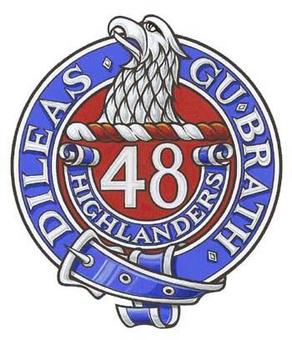
The 48th Highlanders of Canada is a Canadian Forces Primary Reserve infantry regiment based in Toronto, Ontario, parading out of Moss Park Armoury. The regiment is part of 4th Canadian Division's 32 Canadian Brigade Group.

The Royal Highland Fusiliers, 2nd Battalion, The Royal Regiment of Scotland is an infantry battalion of the Royal Regiment of Scotland.

The Royal New Brunswick Regiment (RNBR) is a reserve infantry regiment of the Canadian Army based in New Brunswick. The Royal New Brunswick Regiment is part of 37 Canadian Brigade Group, 5th Canadian Division. The RNBR holds 65 battle honours.

The Nova Scotia Highlanders is an infantry regiment in the primary reserve of the Canadian Army. It is part of 36 Canadian Brigade Group, 5th Canadian Division.

The Toronto Scottish Regiment (Queen Elizabeth The Queen Mother's Own) is a Primary Reserve infantry regiment of the Canadian Army. It is part of 4th Canadian Division's 32 Canadian Brigade Group.
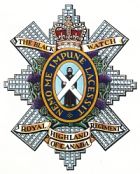
The Black Watch of Canada is a reserve infantry regiment in 34 Canadian Brigade Group, 2nd Canadian Division, of the Canadian Army. The regiment is located at 2067, rue Bleury in Montreal, Quebec, Canada, and is currently commanded by Lieutenant-Colonel R.M. Unger, MMM,CD. The regiment's armoury was designated a National Historic Site of Canada in 2008. They are the senior Canadian-Scottish Regiment.

The Royal Highland Fusiliers of Canada is a Primary Reserve light infantry regiment of the Canadian Army, with companies in Cambridge and Kitchener, and is an infantry sub-unit of 31 Canadian Brigade Group, headquartered in London, Ontario. The Princess Margaret, Countess of Snowdon and The Prince Andrew, Duke of York, as members of the Canadian Royal Family, acted as Colonel-in-Chief.
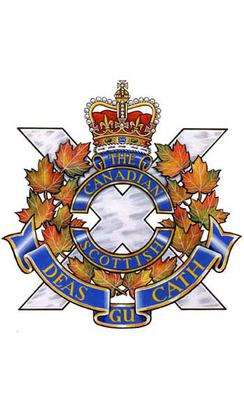
The Canadian Scottish Regiment (Princess Mary's) is a Primary Reserve infantry regiment of the Canadian Army based on Vancouver Island in British Columbia.
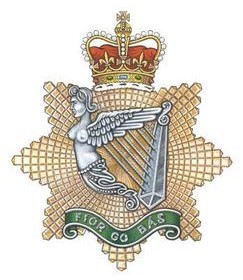
The Irish Regiment of Canada is a Primary Reserve infantry regiment of the Canadian Army based in Sudbury, Ontario. It is part of the 4th Canadian Division's 33 Canadian Brigade Group. Currently one battalion of the regiment exists.

The 19th Alberta Dragoons was a cavalry regiment and later an armoured regiment of the Canadian Militia and later the Canadian Army. It was placed on the Supplementary Order of Battle in 1965. In 2006, it was taken off the Supplementary Order of Battle and amalgamated with the South Alberta Light Horse.
The Peel and Dufferin Regiment was an infantry regiment of the Non-Permanent Active Militia of the Canadian Militia. First organized in 1866 as the 36th Peel Battalion of Infantry, the regiment was reorganized in 1900 as the 36th Peel Regiment. Following the First World War, the regiment was reorganized again in 1920 as The Peel Regiment and for the final time in 1923 as The Peel and Dufferin Regiment. In 1936, the regiment was Amalgamated with The Lorne Rifles (Scottish) to form The Lorne Scots.
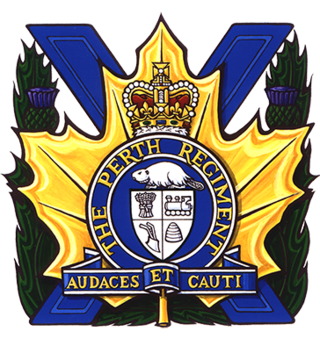
The Perth Regiment was an infantry regiment of the Canadian Army. It is currently on the Supplementary Order of Battle.
The Highland Light Infantry of Canada was an infantry regiment of the Canadian Army. In 1965, the regiment was amalgamated with The Scots Fusiliers of Canada to form The Highland Fusiliers of Canada.
The Prince Edward Island Highlanders was an infantry regiment of the Canadian Army. In 1946, the regiment was amalgamated with The Prince Edward Island Light Horse to form The Prince Edward Island Regiment (RCAC).
The Canadian Fusiliers (City of London Regiment) was an infantry regiment of the Non-Permanent Active Militia of the Canadian Militia (now the Canadian Army). In 1954, the regiment was amalgamated with The Oxford Rifles to form The London and Oxford Fusiliers (now the reserve battalion of the Royal Canadian Regiment).
The 42nd Field Artillery Regiment, RCA is a Canadian Army Reserve artillery regiment based in Pembroke, Ontario. It is part of the 4th Canadian Division's 33 Canadian Brigade Group.
The Oxford Rifles were an infantry regiment of the Non-Permanent Active Militia of the Canadian Militia. In 1954, the regiment was amalgamated with The Canadian Fusiliers to form The London and Oxford Fusiliers.
The Lorne Rifles (Scottish) was an infantry regiment of the Non-Permanent Active Militia of the Canadian Militia (now the Canadian Army). First raised in the 1860s, the regiment was known for most of its existence as The Halton Rifles until 1931 when the regiment was renamed as The Lorne Rifles (Scottish). In 1936, the regiment was amalgamated with The Peel and Dufferin Regiment to form The Lorne Scots (Peel, Dufferin and Halton Regiment).
The Saint John Fusiliers was an infantry regiment of the Non-Permanent Active Militia of the Canadian Militia. In 1946, the regiment was amalgamated with The New Brunswick Rangers to form the South New Brunswick Regiment which was later renamed as The New Brunswick Scottish. They now form part of the 1st Battalion, The Royal New Brunswick Regiment.
The Argyll Light Infantry was an infantry regiment of the Non-Permanent Active Militia of the Canadian Militia. In 1936, the regiment was converted from infantry to form one of the Canadian Army's first tank units, and then in 1946 was converted to anti-tank artillery. In 1954, the regiment was converted back to infantry and amalgamated along with The Midland Regiment into The Hastings and Prince Edward Regiment.